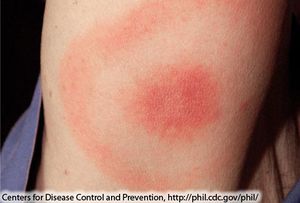Borrelia burgdorferi and Lyme Disease Pathogenesis
From MicrobeWiki, the student-edited microbiology resource
Research Question: Why is the bacterium so good at evading the host's immune response? [1]
Section 1: Overview of Borellia Burgdorferi

Figure 1. A scanning electron micrograph of a cluster Borrelia burgdorferi bacteria. Micrograph taken by Claudia Molins at the CDC in 2011. [http://phil.cdc.gov/phil/details.asp?pid=13176}.

Figure 2. Diagram of spirochete showing the flagella and the flagellar motor in between the outer and inner membrane. [http://www.sciencedirect.com/science/article/pii/S1369527415001368
Section 2: Lyme Disease Overview

Figure 3. Diagram of B. burgendorferi life cycle and transmission from tick host to other organisms. [http://www.nature.com/nrmicro/journal/v10/n2/fig_tab/nrmicro2714_F1.html

Figure 4. Photo of erythema migrans rash following a tick bite. [http://www.cdc.gov/lyme/signs_symptoms/rashes.html
Section 3: B. Borgendorferi use of magnesium to avoid immune response

Figure 5. Results of experiments by Troxell et al. showing the expression level of the protein SodA when exposed to different metal compounds. [http://www.jbc.org/content/287/23/19284.long
Section 4: Tick saliva immunosuppressant

Figure 6. Results showing the expression of Scalp15 in uninfected and infected ticks. [http://www.nature.com/nature/journal/v436/n7050/fig_tab/nature03812_F1.html
Section 5: B. burgendorferi escaping the blood stream

Figure 7. The observed interactions between B. burgendorferi and the vasculature in mice. [http://journals.plos.org/plospathogens/article?id=10.1371%2Fjournal.ppat.1000090
Section 6: Borrelia burgendorferi resistance to antibiotics
Section 7: Borrelia burgendorferi Outer Surface Proteins and possible vaccine
Section 8: Current Research
References
- ↑ [1]=Troxell, Bryan, Haijun Xu, and Frank Yang. "Borrelia Burgdorferi, a Pathogen That Lacks Iron, Encodes a Manganese-dependent Superoxide Dismutase Essential for Resistance to Streptonigrin." Borrelia Burgdorferi, a Pathogen That Lacks Iron, Encodes a Manganese-dependent Superoxide Dismutase Essential for Resistance to Streptonigrin. Journal of Biological Chemistry, 12 Apr. 2012. Web. 17 Apr. 2016.
Authored for BIOL 238 Microbiology, taught by Joan Slonczewski, 2016, Kenyon College.
